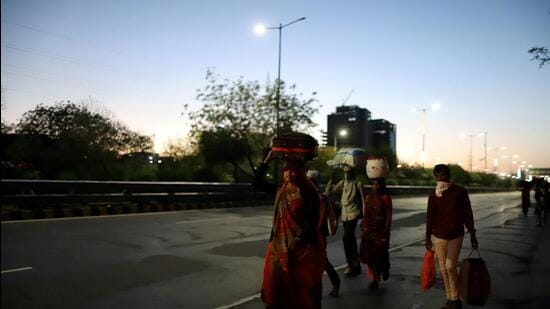Inequality worries bigger than what NFHS illustrates
In the first of a five-part data journalism series based on National Family and Health Survey (NFHS) data, HT's data and political economy team finds that India's inequality problem is far sharper than what is made out by the data
The fifth round of the National Family and Health Survey (NFHS), conducted between June 2019 and May 2021 was among the biggest in India. It was conducted in all of India’s 707 districts (as on March 31, 2017) and its sample included 101,839 men, 724,115 women and 636,699 households. NFHS sought information on a variety of metrics and issues, making it a rich source of information on India’s economy and society. While summary findings of NFHS-5 were released last year, unit-level data – this makes it possible to retrieve information beyond tables given in the report – were only released earlier this month.

Based on its analysis of the NFHS data, HT’s data and political economy team has put together a five-part series data journalism series, which will appear over the course of this week.
India has an inequality problem and it is far sharper than what it is made out to by NFHS data.
Here are three charts that explain this.
More people own basic assets and amenities now than before
NFHS sought responses from households on ownership of 26 assets and amenities. A comparison of results from the fourth (2015-16) and fifth (2019-21) rounds of NFHS shows that there has been an increase in ownership of all assets except ones which are likely obsolete now. For example, the share of households owning a radio has declined from 8.4% to 4.9%.
Of the 17 of 22 assets (some have been clubbed together for simplicity) that show increase in ownership, the five that show the biggest proportional increase are internet connectivity, washing machines, coolers and air conditioners (NFHS does not differentiate between the two), motor vehicles (this includes cars, two-wheelers, and tractors), and refrigerators. The five assets that show the least increase are beds, phones, televisions, computers, and tables. To be sure, all the five assets that show the biggest increase were owned by less than 50% people in 2015-16, and the all five assets with the least increase (except computers) were owned by more than 50% back then. However, some of the assets that have shown less growth – such as televisions and computers – have indeed not reached saturation levels. That 93% owned mobile phones even in 2015-16 (this is now 95.5%), may actually explain why growth of computers and televisions is lagging.
Socially disadvantaged classes are now better represented among the richest
The assets shown above are only a subset of assets that NFHS captures. NFHS unit-level files also combine the data on over 130 assets and amenities, assigning more weight to assets which can explain the difference in wealth among households the most. This information is used to rank households from the richest to the poorest in each round. This wealth index shows that the proportion of all the traditionally socially disadvantaged class and caste groups – the Scheduled Tribes (STs), the Scheduled Castes (SCs), and the Other Backward Classes (OBCs) – belonging to the richest 20% segment in India has increased since 2015-16. To be sure, the degree of upward mobility is different for these groups. The proportion of SCs in the bottom three quintiles has decreased and that in the top two quintiles, increased. The proportion of OBCs, on the other hand, has decreased only in the bottom quintile, but by the biggest degree. Moreover, despite a bigger share of their groups now present among the richest 20%, all three groups remain under-represented in the top 20% relative to their share in thepopulation.
Regional inequality has not improved much
If the richest of the country were not geographically concentrated, 20% of the population of each state would belong the richest quintile. That is clearly not the case. 16 of the 35 states and Union territories (UTs) (for comparison across rounds Jammu and Kashmir and Ladakh; and Dadra and Nagar Haveli and Daman and Diu have been taken as single territories respectively) had less than 20% of their population in the richest quintile in 2015-16. In eleven of them – the big states among them being Madhya Pradesh, Chhattisgarh, Andhra Pradesh, Jharkhand, West Bengal, and Assam – the share of the richest is now even smaller. However, in five states (Bihar, Odisha, Uttar Pradesh, Rajasthan, and Sikkim), the share of the richest has increased. To be sure, Bihar and Odisha still rank 5th and 10th from the bottom on this metric. Since the wealth index distributes the country’s population equally into five groups, it is obvious that the increase in share of the rich in some states will lead to a decline in their share in others. However, Karnataka is the only state where the share of the richest has declined from being at the 20% mark in 2015-16 to below it (18.9%) in 2019-21.
NFHS may not show the complete picture on inequality
Most questions in NFHS only ask households if they own the asset or not, and leave out details on number, type, or the expenditure on the asset. For example, households that own four smartphones and those that own a single non-smart mobile phone will both respond “Yes” to owning a mobile phone.
There is reason to believe that this problem might have become more acute after the pandemic. For example, a CRISIL research note dated May 16 said that the growth in domestic sale of cars worth more than ₹10 lakh was five times more than that of cars below ₹10 lakh in 2021-22. While this suggests a growing divide even within the ranks of the rich, NFHS data will not be able to capture it.
To be sure, NFHS is not the only data source whose inequality findings are contested. For example, a comparison of data from National Statistical Office’s (NSO) debt and investment surveys shows that asset inequality decreased in India between 2012 and 2018. However, a working paper by economists Rishabh Kumar and Ishan Anand — its summary findings were published here — argues that the actual decline in inequality might be smaller than what NSO data shows.
While these debates add to a better understanding of the inequality problem in India, they are no substitute for consumption expenditure survey data, which is the only official source of consumption inequality in the country.
This is the first of five-part data journalism based on NFHS data. The second part will look at food habits of Indians.








